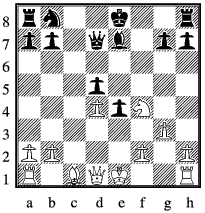
January 2013
Division 1
|
Division 2
|
Just one round of second division matches in what is after all a truncated month, with Cheddleton's defeat of Newcastle in the clash of B teams increasing the chances that this competition will be a shoot out between our moorland friends. At the other end of the table Macclesfield remain sleeping giants for at least another month.
Division 3
|
Division 4
|
Fenton B's progress has been slowed by a couple of postponement, Meir B's by a couple of defeats so that the Cheddleton twins have been able to enjoy Christmas looking down on the rest.
Holmes Chapel Tiny Pawns picked up their first points in their maiden year so as to engage Newcastle E in a fight to avoid the wooden spoon.
The North Staffs Doubles, a new event held at Holmes Chapel, attracted ten pairs, with Mike Hancock and Ian Chester taking the 320 honours, and Dave Price and Paul Clifford securing the 220 title.
No defaulted boards to report in December, and the treasurer has told me of no ineligible players caused by lack of ECF membership. Certainly all those who have played 4 or more games in the Association's events are currently ECF members.
In terms of players outperforming their grades, amongst those playing at least 5 games Eddie Burke (Meir) and Peter Evans (Stafford) lead the way with an outperformance of 34 points, ahead of Ian Bates (Holmes Chapel) with 31. For those clocking up at least 10 games Dominic Taylor leads with an outperformance of 23, followed by John Yee (19), with Jack Healings and the first non-Cheddleton player Rob Taylor (Fenton) on 13.
Leading out-performances at clubs not already mentioned:
Alsager: Michael Matar (27), Kidsgrove: David Johnson (17), Newcastle: Derrick Jones (10). Only a couple of Macclesfield players have reached the 5 game mark, and their performances to date are in negative territory.
The league's most active players are George Scattergood (Holmes Chapel) and Pete Shaw (Newcastle) who have both fitted in 15 matches before Christmas, two ahead of eight players hailing from Alsager, Cheddleton, Fenton, Meir and Newcastle. At the other end of the scale twenty three players are yet to show that they are anything other than one hit wonders. Or people who have kindly turned out to enable the club to avoid a board default.
comment on this article
3 e4 d6, 4 g3 Nf6, 5 Bg2 c6, 6 d4 fxe4 Close decision as to which pawn to capture, but decided that exd4 helps white get up a head of steam against my d-pawn.
7 Nxe4 Be7, 8 Ne2 Nxe4, 9 Bxe4 d5 Greedy. Nd7 is surely better. Taking over the light coloured central squares is OK as far as it goes, but white can undermine with f3 at a time of his choosing anyway.
10 cxd5 cxd5, 11 Bd3 e4, 12 Bb5+ Bd7, 13 Bxd7+ Qxd7 14 Nf4 to reach the position in the diagram.

|
| Luis R-R v RR after 14 Nf4 |
14 ... Nc6 I'm sure I was going to castle first!
15 Qh5+ Kf8 hardly the best king move as it takes the h8 rook out of the game.
16 Ng6+ Hmm. Kf7 and get mated, Ke8 allows RxN with discovered check, so looks like
16 ...Kg8, 17 Nxh8 Kxh8 and a rapid solution to my h8 rook problem. But why play like that when you can play like this:
16 ... hxg6, 17 Qxh8+ Kf7, 18 Qxa8 Nxd4
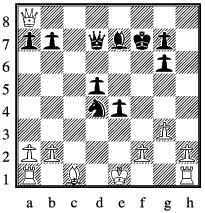
|
| Luis R-R v RR after 18 ... Nxd4 |
19 ... Nf3+, 20 Kd1 Avoiding Ke2 Qb5+, 21 Ke3 Bg5#. (21 Kd1 fares little better)
Had he chosen Kf1 I would probably have to settle for some sort of draw by repetition as Qb5+ enables the king to reach the safety of g2, whilst Qh3+ permits the king to move to e2 safely.
20 ... Qa4+, 21 Kc1 Qc4+, 22 Kd1 Qd3 0-1 RR fumbles his way to a kill. White still has a considerable material advantage, but with his major pieces occupying 3 corners of the board black had superior force in play.
comment on this article

|
| RR v Brendan Brown after 9 ... Qh5 |
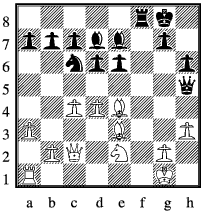
|
| RR v Brendan Brown after 17 ... h6 |
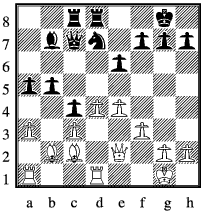
|
| Barry Marshall v RR after 21 Rfd1 |
23 Bc1 Ra8, 24 Rb1 Qc6, 25 Be3 Ba6, 26 d5 exd5
27 exd5 Qd6, 28 Bc5 Qe5, 29 Bxf8 Kxf8 This exchange of minor pieces is an unexpected bonus for RR
30 Qd4 Qxd4+ 31 Rxd4 and I really shouldn't be complaining about the exchange of queens either. Any sensible analysis suggests that progress for white will be difficult if black simply sits on the position. So Ke7 (Rook checks are not to be feared) and then Kd6. Kings can be excellent blockading pieces. Instead RR looks for immediate pressure on the d-pawn by doubling rooks against it, even though rooks are less good blockaders.
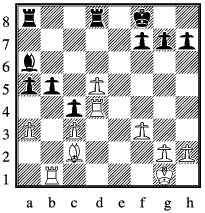
|
| Barry Marshall v RR after 31 Rxd4 |
35 Bf3 Rb6, 36 Rxc4 White spots the pin. RR should have played R6d7.
36... Kd6, 37 Rc6+ Rxc6, 38 dxc6 Kc5, 39 Re1 Rd3, 40 Re5+ Kb6
41 Re3 Rd2+, 42 Ke1 Ra2, 43 Re7 Rxa3, 44 Kd2 b4 RR is keen to be able to get his rook behing the c6 pawn, but Ra2+ is better as white cannot play Kd3 because the discovered check b4 would give RR some powerful connected passed pawns. Meanwhile RR's neglect of his defence of his kingside pawns means white can mop these up and win later on that side of the board.
45 cxb4 axb4, 46 Rxf7 Rc3 47 Rxh7 Rc5 Automatically assuming that a black square is superior when c4 is better. The rook here still cuts off the king from the b-pawn and prevents Be4. Further RR would have good survival chances in the rook ending if white plays Be2 to exchange the bishops.
48 Re7 b3, 49 Re1 Rc2+, 50 Ke3 b2, 51 Rb1
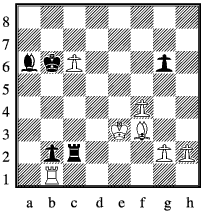
|
| Barry Marshall v RR after 51 Rb1 |
52 Be4 Re2+, 53 Kf3 Kd4, 54 Bxg6 Re3+, 55 Kg4 1-0
Can't help feeling that RR played the latter part of the game as if he didn't believe he could survive, which is an essential element for anyone playing on in an inferior position.
comment on this article
The afternoon game with RR black against Geoff Smith took a similar course. Momentarily Geoff threatened a significant kingside attack, but this threat quickly dissipated, and we were en route for a rook and minor piece ending in which RR was starting to call the tune, with Geoff's rook tied down to the defence of a pawn. And then Geoff ran out of time, so we'll never know whther RR could have converted. Two relative non-events in one day, but two points gleaned.
comment on this article
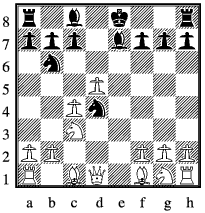
|
| Jean-Paul Taylor v RR after 10 Kd1 |
10 ... a6, 11 Be3 Nf5, 12 Bxb6 cxb6 Having moved the a-pawn the c-pawn recapture is forced, and white has the pleasure of playing with a supported passed pawn.
13 Nf3 0-0, 14 Bd3 Bf6 another waste of time
15 Ne4 Be7, 16 Re1 Bb4, 17 Re2 Nd6 RR blithely continues to use just two pieces. Whatever happened to that lead in development?
18 a3 Nxe4, 19 axb4 Nf6, 20 b5 a5 RR appears allergic to moving his bishop.
21 Ne5 Bd7, 22 h3 Rfd8. I'd rather be using the other rook to protect the bishop to release the knight from defensive duties, but feel a need to keep an eye on the a-file.
23 g4 g6, 24 Re3 Kf8, 25 Rf3 White is about to increase his material advantage to go with his positional one.
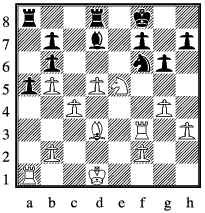
|
| Jean-Paul Taylor v RR after 25 Rf3 |
Not all the blame for defeat can be laid at the door of the a6 move, but it turned a decent position out of the opening into one in which RR was always (unsuccessfully) searching for a plan.
comment on this article
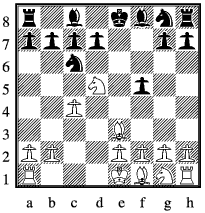
|
| Alan Paling v RR after 7 Bxe3 |
7 ... Bb4+, 8 Bd2 Bxd2+, 9 Kxd2 Kd8, 10 Nf3 h6 as much to enable a later g5 as to stop a second knight from threatening forks.
11 e3 d6, 12 Bd3 Nge7, 13 Nxe7 Kxe7 Happy to see this exchange. I'd no desire to play Nxd5 myself as the recapture could have long term consequences for my c-pawn and/or my ability to maintain a decent pawn structure. Further my king is moving into the game and freeing up the movement of my queen's rook.
14 Nd4 Nxd4 Ne5 more aggressive, but I'm operating in boring mode.
15 exd4 Bd7, 16 Rhe1+ Kf6, 17 f4 Rae8, 18 g3 b6
19 d5 Rxe1, 20 Rxe1 Re8, 21 Rxe8 Bxe8, 22 Ke3 Bd7=
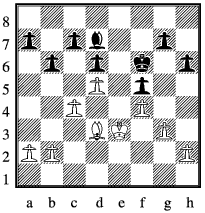
|
| Alan Paling v RR after 22 ... Bd7= |
23 b4 g6, 24 Kd4 Kf7, 25 c5 Bc8, 26 a3 Ke7, 27 Bb5 Bb7
28 cxb6 cxb6, 29 a4 Bc8, 30 a5 a6, 31 Bc6 bxa5, 32 bxa5 Kd8 The queenside pawns are set to deny entry to the kings on that side of the board, so I'm happy to prepare to offer an exchange of bishops. we could easily get a position in which both sides have plenty of legal king moves but no way into the enemy position.
33 Ba4 Bd7, 34 Bc2 Ke7, 35 Bd3 Bc8, 36 Ke3 Kf6, 37 Bc2 Bd7 Black is just sitting on the position seeking to deny white a way in.
38 Bd3 Bc8, 39 Kf3 h5 (probably better not played)
40 Kg2 Bb7, 41 Bc4 Bc8, 42 Kf3 Kf7, 43 Ke3 Ke7, 44 Be2 Kf7
45 h3 Kf6, 46 Bd1 Bd7, 47 Be2 ½-½
comment on this article
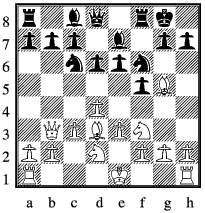
|
| Jon Blackburn v RR after Qd1-b3 |
8 ... Na5, 9 Qc2 Qe8 threatening to launch a kingside attack should Jon castle short.
10 0-0-0 b5, 11 h4 c5 As tradition dictates, castling on opposite wings leads to some rapid pawn advances. Whilst not overly fond of his g5 bishop I'm not going to waste time kicking it away.. Jon however feels obliged to take note of my advances. Can't say I blame him.
12 dxc5 dxc5, 13 Nb3 Nxb3, 14 axb3 The knight exchange does not further Jon's cause. Although RR can't play the fork
13 ... c4, 14 Nxa5 cxd3, 15 Rxd3 as it loses a pawn, in the game line white is forced to recapture with the a-pawn to prevent an effective fork with c4 now.
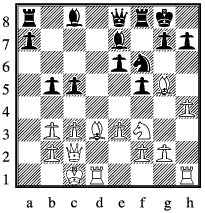
|
| Jon Blackburn v RR after 14 axb3 |
19 ... gxf6, 20 Nxc4 My immediate reaction is to try ganging up on the knight, but do I get anywhere after
20 ... Qc6, 21 Ba2 Rac8, Rd4 as I don't have e5 as the knight moves with discovered check? Anyway I'm after bigger fish.
20 ... a3, 21 b3 Bxc4
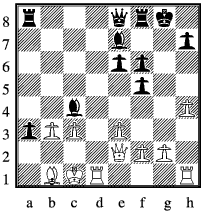
|
| Jon Blackburn v RR after 21 ... Bxc4 |
Despite the poor weather we didn't have to work hard to get there. Local roads in Newcastle were fine, as was the motorway and the ringroad in Walsall which took us close to the venue. The couple of hundred metres of local road in Walsall were different, and the car park nedded delicate negotiation. But by then we weren't goingto turn round and go back.
We lost the toss which meant that RR got white in his game against David Pritchard.
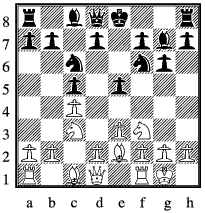
|
| RR v David Pritchard after 6 ... Nf6 |
7 d4 e4, 8 Ne5 lacking the courage to play Ng5, but anticipating black unlikely to want to play
8 ... Nxe5, 9 dxe5 Ng8
8 ... Qe7, 9 Ng4 0-0, 10 Nxf6 Bxf6, 11 Nd5 Qd8, 12 Nxf6 Qxf6
Can't help liking my position. Holes around his king, with a dark squared bishop to exploit them, whilst he still has problems getting his queenside pieces into the game. Makes me feel distinctly nervous, knowing that I should be able to win from here, but that a few weak moves could dissipate the advantage.
13 dxc5 Re8, 14 Rb1 making sure that I don't suffer any problems myself on the a1h8 diagonal, and preparing a b-pawn advance. However my alternative ideas of f3 to open the f-file against his queen and f7, or f4 keeping his knight out of e5 unless he is prepared to have the f-file opened may well have been stronger.
14 ... Qg5 I now start to worry about blacks possibilities of moving d-pawn, Bh3 and maybe Ne5 so decline the chance to play b4 even though I reckon that with care the attack outlined can be repelled since if I've overlooked something I could come to a rapid sticky end.
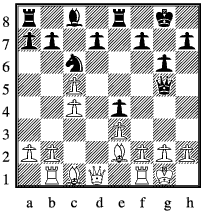
|
| RR v David Pritchard after 14 ... Qg5 |
20 Bc3 Not totally sure what that was about as having the bishops together on the second when ne plays Ra2 is not a disaster, and I'm not going to want to exchange my dark-squared bishop for his knight should it appear on b4.
20 ... axb3, 21 axb3 Ra2, 22 Bg4 Bf1 probably better, but I'm not totally convinced I won't need that square for a rook. Besides now after
22 ... f5, 23 Bh3 it will take him a few moves to arrange alternative protection for the f-pawn, his g-pawn being pinned.
22 ... Re8 An unexpected retreat (right), which David later admitted was because he had overlooked the possibility of f5
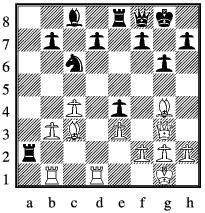
|
| RR v David Pritchard after 22 ... Re8 |
26 Qf4 Qa3, 27 Rf1 Rc1, 28 g3 Wish I had played this last move, daring him to play the losing Rc1+. The rest of the games had finished by now, and we had picked up just half a point on the other five boards. So the match had gone, but it meant we had plenty of spectators.
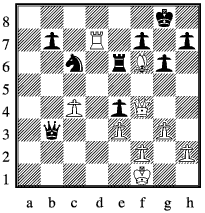
|
| RR v David Pritchard after 29 ... Qxb3 |
RR simply played Qb8+, announcing that he wished to play on. After checking that I really would not prefer the draw, David resigned.
For those not understanding the comment about the losing Rc1+:
27 g3 Rc1+, 28 Rxc1 Qxc1+ (else loses the rook)
29 Kg2 Qa3 (to stop Qb7+ being effective)
(... Rxf6, 30 Qxf6 and the major pieces deliver mate)
30 Rxf7 Kxf7, 31 Bb2+ and the queen dies.
We see that black in the game would have struggled to find a good 29th move, and that white was liable to be able to grab the b-pawn and shove his queenside pawns to victory.
comment on this article